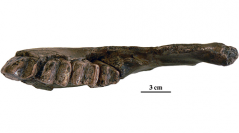

 Comptes Rendus Palevol
13 (4) - Pages 259-266
Comptes Rendus Palevol
13 (4) - Pages 259-266Two recent discoveries in two “lagoas” of southeastern Piauí (North East of Brazil) allow us to describe and compare two very small-sized hemimandibles of two Megatheriidae. We attribute the first one, from the Lagoa dos Porcos, to a very young specimen of Eremotherium rusconii (Schaub, 1935), the gigantic Eremotherium well known in South America. We determine the other one, from the Lagoa do Quari, as an adult specimen of the small Eremotherium laurillar di (Lund, 1842). We confirm hereby our idea, written in 2000, of the reality of the latter species, which was not defined, like many authors think, on a juvenile tooth of the large species. The mandible of E. laurillardi is described for the first time. The mandible of the very young specimen of E. rusconii is also a rare piece.
Duas descobertas recentes em duas lagoas no Sudeste do Piauí (Nordeste do Brasil), permitem-nos descrever e comparar duas meias mandíbulas de Megatheriidae muito pequeno. Atribuímos uma a um jovem Eremotherium rusconii (Schaub, 1935), o grande Eremotherium , bem conhecido na América do Sul, e outra, a um indivíduo adulto de Eremotherium laurillardi (Lund, 1842). Ao fazê-la, confirmamos a idéia de que havíamos emitido em 2000, esta última espécie existe e ainda não foi definida, como alguns autores acreditam que, a partir de um indivíduo jovem do grande E. rusconii. Esta é a primeira vez que uma mandíbula do E. laurillardi é descrita. A mandíbula do muito jovem E. rusconii publicado aqui para comparação também é um espécime pouco frequente.
Mammalia, Xenarthra, Megatheriidae, Upper Pleistocene, Brazil